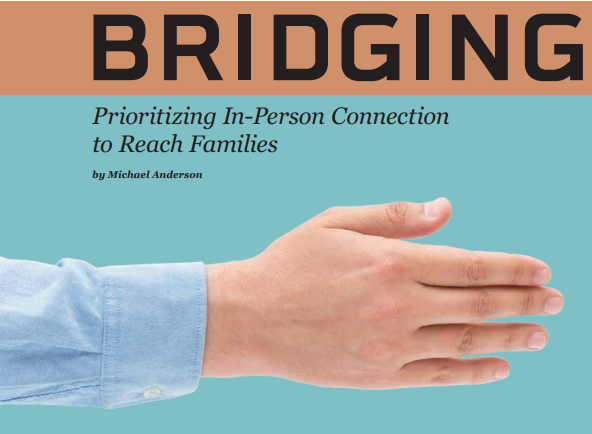(404) 312-6640
Bridging the Gap
There is nothing quite like human connection. When we meet and speak with someone face to face, we develop meaningful bonds. In the funeral profession, these moments are crucial for demonstrating a funeral home as a trustworthy, compassionate place filled with empathetic, professional people.
However according to the 2024 NFDA Consumer survey, only 16 percent of people today choose to work with a funeral home due to an existing relationship with a funeral director. This number is down from 2023 and highlights a troublesome trend and a growing gap between funeral homes and their communities.
FUNERAL HOMES AND TODAY’S COMMUNITIES
We can look at the issue of this developing gap in multiple ways, as there are several factors at play here. To begin, families are becoming more transient than they have been in previous generations. Many adults are no longer living in the communities they grew up in. As such, it’s becoming far less often that a family will continue to use one funeral home throughout every generation, as each generation may be living in a different location. Though a funeral home may have developed a relationship with a set of grandparents when they were younger many years ago, their grandchildren may have no such relationship and live across the country.
Another factor playing an integral role in this disconnection is that the art of community connection is falling by the wayside. While we see this change happening in the funeral profession, it’s essential to note that it’s not limited to funeral professionals. Only about half of Americans say that they feel close to their community, according to the Pew Research Center. Previous generations of funeral professionals saw themselves as trusted pillars of support in their community. Through being part of local Rotary and Kiwanis clubs, sponsoring or participating in local events, supporting local sports teams, or even simply introducing themselves to new business owners in their town, they built connections, and through those connections, they fostered community.
This is not to say that all funeral homes have forgotten these efforts, but we have seen a pattern of funeral homes losing this part of their outreach. And they have an understandable reason for doing so.
OUTREACH AS A PART OF MARKETING
These outreach efforts are part of a greater marketing strategy, and many funeral homes today are being pulled in several different directions when it comes to developing a marketing plan.
There are a lot of shiny pennies in the marketing world, like generative AI and other flashy new technologies. It’s easy to understand why a funeral home might feel that its marketing plan and budget need to go to the next tech revolution in marketing. While some of these shiny pennies may be worthwhile, they can also draw attention and budget away from the most effective tool in a funeral home’s marketing arsenal: in-person connection.
Today’s consumer journey includes both digital and non-digital channels. Throughout any given day and throughout their lives, people interact with both digital and physical environments. By limiting yourself to a digital environment only, you are not having a consistent and optimized presence in a family’s consumer journey to choose a pre-need or atneed provider.
Consider this: while social media does have targeted advertising, it’s very difficult to use it to specifically target families who may be in an at-need situation. Moreover, a social media ad, while still a valuable touchpoint, must compete for attention in an overly saturated channel. While social media advertisements may stay in our subconscious to be called upon later, the truth is that we see so many of these ads every day that it’s easy for one ad to be lost in the shuffle.
In an increasingly digital world, more and more people are turning to the digital landscape for advertising their services. When you decide to include outreach as a part of your marketing efforts, you can set yourself apart from competitors who may place less emphasis on the value of face-to-face connection.
As a standard rule of thumb, it takes a consumer seven to eight interactions, also known as touchpoints, with a brand before that consumer decides to make a purchase. Maybe your competitors have turned their touchpoints digital, but you can leverage the power of both digital and analog touchpoints. Someone clicking your ad on Facebook is a touchpoint. But so too is your funeral director talking with local business owners or your staff working at a local community event.
From our experience, we would go even further to say such in-person interaction is worth two or even three touchpoints. None of this is to say that digital marketing does not have its value, but it is to say that, when used together, digital and in-person marketing build off each other.
Consider a family that’s moving across the country. They do not know anyone on the other coast and don’t yet feel like a part of their new community. One day, they wander into a local coffee shop in their new town. It’s there that they see a flyer for an upcoming Block Party, sponsored by your funeral home. Thinking it’s a great opportunity to meet new people, they attend, where they stop by your booth and chat with one of your funeral directors, who not only tells them about upcoming events and your services but also offers their expertise as a local to tell them all about the best places to go in town.
Later on, while interacting online, they see a display ad for an upcoming lunch and learn at your funeral home, with the friendly face of the funeral director they already know greeting them on their screen. They decide to attend, where they learn about your pre-need offerings and connect with more members of their community. Or perhaps the display ad triggers them to Google more information about what pre-need entails and a blog post from your website is the first result, which directs them to a place to schedule a pre-need consultation.
In just that one example, there are at least five touchpoints, though, as we mentioned, those in-person touchpoints could easily count for more. The marriage of the in-person interactions, like the lunch and learn and the Block Party, and the digital interactions, like the display ad and the blog post, create one powerful marketing plan.
IN-PERSON MARKETING IN PRE-NEED AND AT-NEED SITUATIONS
You know that, in the funeral profession, it’s not possible to create demand. So, you know the value of pre-need marketing. In-person interactions and outreach efforts help you stay top-of-mind for families, which can help you create awareness of and interest in pre-need services.
These efforts also help you solidify relationships with local families. These relationships enable you to build trust, and, in such a sensitive situation as an at-need circumstance, you know that trust is fundamental. Actively maintaining relationships can keep families in your orbit, so that when the time is right, they’re pulled toward you as someone they can trust in their most challenging moments.
If you’re already doing community outreach, we’re happy to report that you’re likely one step ahead of your competition. But we also find it’s valuable to sometimes go over these outreach efforts and find opportunities for improvement. Communities change over time, so outreach efforts may need to change, too. You may want to look at shifting focuses or incorporating new places and spaces. You don’t want to sever the connections that you’ve already made, but you do want to take a close look at the demographics, values, lifestyles, and budgets of those who have moved into the community throughout the generations. Consider doing some market research to pinpoint new segments of your market that may not have been exposed to your brand yet.
While other industries may be able to move away from hands-on brand awareness and embrace more digital, behind-a-screen tactics, the funeral profession is simply too people-centric and community-centric to forgo in-person interactions. Digital marketing tactics do have a place in the funeral profession, but it’s crucial to find a balance that allows for time and budget to go toward in-person connections. When a funeral home can find this balance, they’ll be able to build a bridge that crosses the gap between funeral homes and communities, embracing both forward-thinking innovations while not forgetting the importance of knowing and befriending their neighbors.






Comments